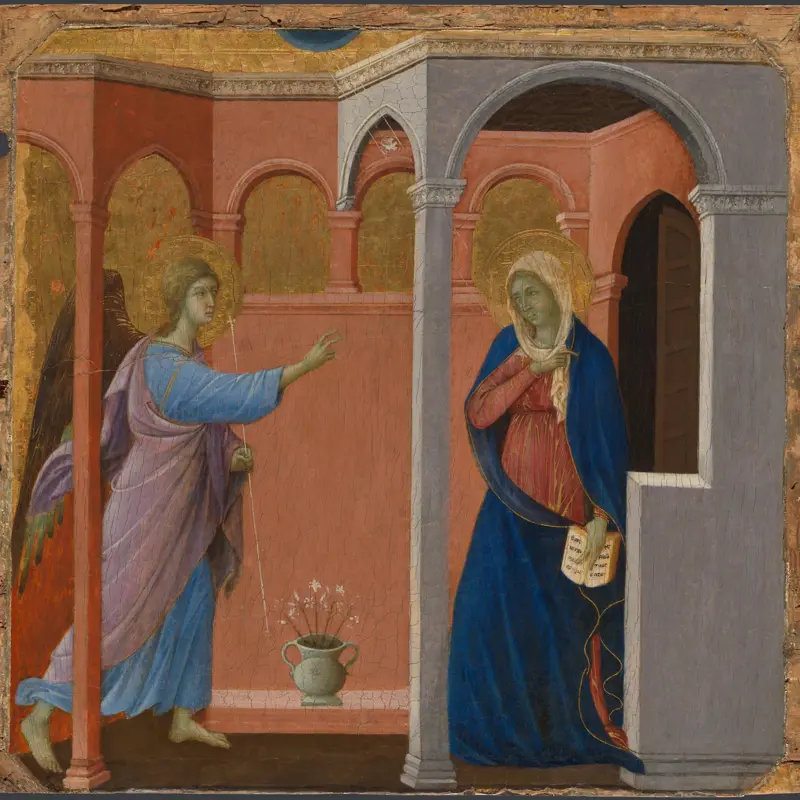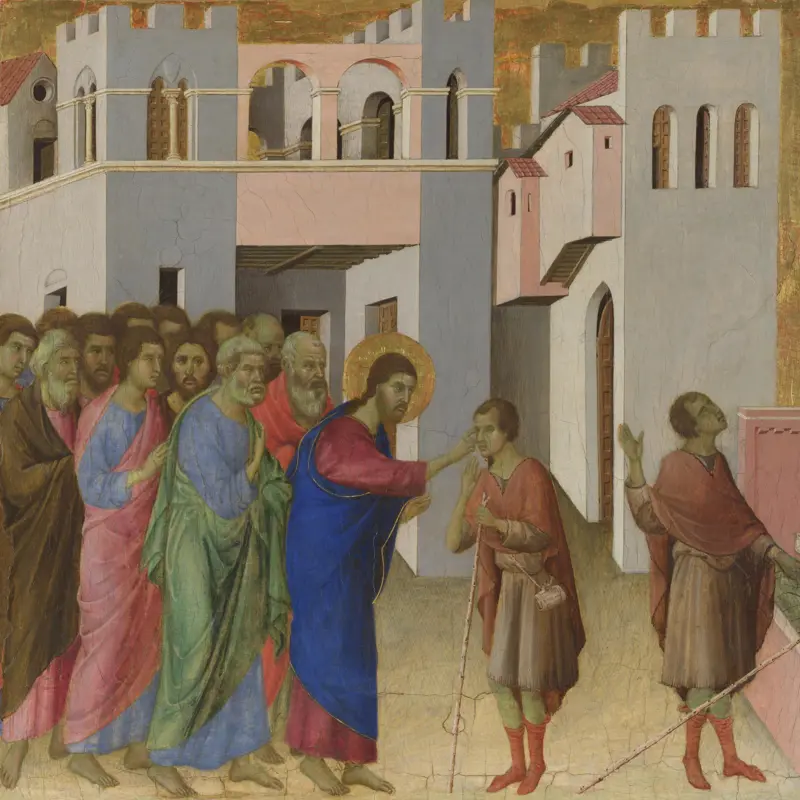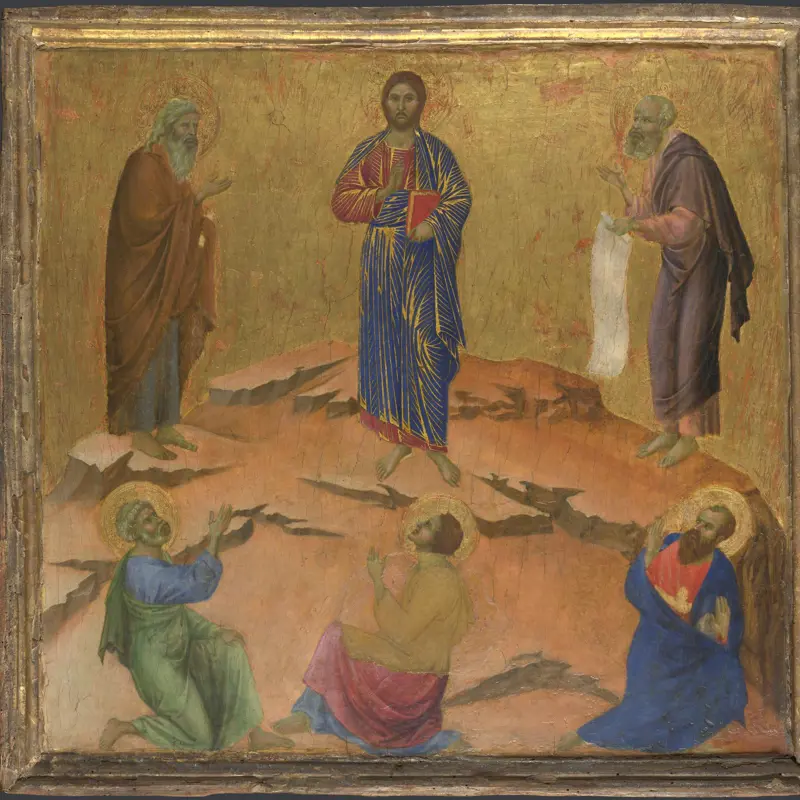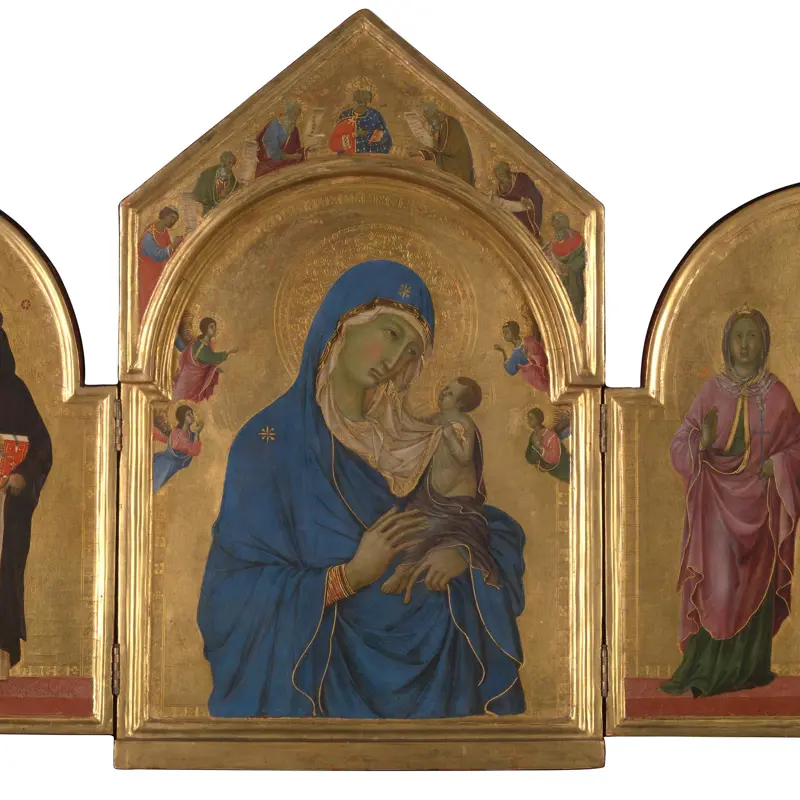Duccio, 'The Transfiguration', 1307/8-11
About the work
Overview
Christ stands at the centre of this small square panel. The moment shown is the Transfiguration, when Jesus ascended a mountain and became filled with heavenly light, shown here by the golden striations (stripes) on his robes. Suddenly the Old Testament prophets Moses (on his left) and Elijah (on his right) appeared and began to speak with him. God then spoke, singling out Christ as divinely favoured: ‘This is my beloved Son, with whom I am well pleased; listen to him.’
Jesus’s disciples, at the bottom of the mountain, raise their hands in fear, dazzled by the sight. This scene was the eighth of nine images that formed the back of the predella (lowest part) of the Maestà, a five-tiered, double-sided altarpiece. It was the focus of the devotion of the Virgin in Siena and it is the only known signed work by the city’s leading artist, Duccio di Buoninsegna.
Key facts
Details
- Full title
- The Transfiguration
- Artist
- Duccio
- Artist dates
- Active 1278, died 1319
- Part of the series
- Maestà Predella Panels
- Date made
- 1307/8-11
- Medium and support
- Egg tempera on wood (probably poplar)
- Dimensions
- 48.5 × 51.4 cm
- Acquisition credit
- Presented by R.H. Wilson, 1891
- Inventory number
- NG1330
- Location
- Room 58
- Collection
- Main Collection
- Frame
- 14th-century Sienese Frame (original frame)
Provenance
Additional information
Text extracted from the ‘Provenance’ section of the catalogue entry in Dillian Gordon, ‘National Gallery Catalogues: The Italian Paintings before 1400’, London 2011; for further information, see the full catalogue entry.
Exhibition history
-
2019Louise Giovanelli: Bridging TraditionManchester Art Gallery1 June 2019 - 1 September 2019
Bibliography
-
1892National Gallery, Descriptive and Historical Catalogue of the Pictures in the National Gallery with Biographical Notices of the Painters: Foreign Schools, London 1892
-
1951Davies, Martin, National Gallery Catalogues: The Earlier Italian Schools, London 1951
-
1979J.H. Stubblebine, Duccio di Buoninsegna and His School, Princeton 1979
-
1985R.W. Sullivan, 'The Anointing in Bethany and Other Affirmations of Christ's Divinity on Duccio's Back Predella', Art Bulletin, LXVII/1, 1985, pp. 32-50
-
1986Davies, Martin, National Gallery Catalogues: The Earlier Italian Schools, revised edn, London 1986
-
1988Gordon, Dillian, National Gallery Catalogues: The Early Italian Schools before 1400, revised edn, London 1988
-
1989G. Ragionieri, Duccio: Catalogo completo dei dipinti, Florence 1989
-
1989D. Bomford et al., Italian Painting before 1400 (exh. cat. The National Gallery, 29 November 1989 - 28 February 1990), London 1989
-
1994A. Thomas, An Illustrated Dictionary of Narrative Painting, London 1994
-
1997A. Weber, Duccio di Buoninsegna: About 1255-1319, Cologne 1997
-
1998L. Bellosi, Duccio: La Maestà, Milan 1998
-
2001
C. Baker and T. Henry, The National Gallery: Complete Illustrated Catalogue, London 2001
-
2011Gordon, Dillian, National Gallery Catalogues: The Italian Paintings before 1400, London 2011
-
2024J. Cannon, C. Campbell and S. Wolohojian (eds), Siena: The Rise of Painting 1300-1350 (exh. cat. Metropolitan Museum of Art; National Gallery, London), London 2024
Frame
Originally part of the back of the predella of a huge altarpiece, The Transfiguration was one of nine scenes painted on a continuous board of wood. The frame mouldings around the scene are original, glued to the front of the panel, as can be seen at the side edges where the main board has been sawn to separate the scenes into individual panels. Canvas and gesso preparing the panel for painting are continuous over the frame mouldings.
Notably, some of the original water gilding, dating from around 1307–8, is still visible, although there has been extensive regilding.
About this record
If you know more about this work or have spotted an error, please contact us. Please note that exhibition histories are listed from 2009 onwards. Bibliographies may not be complete; more comprehensive information is available in the National Gallery Library.
Images
About the series: Maestà Predella Panels
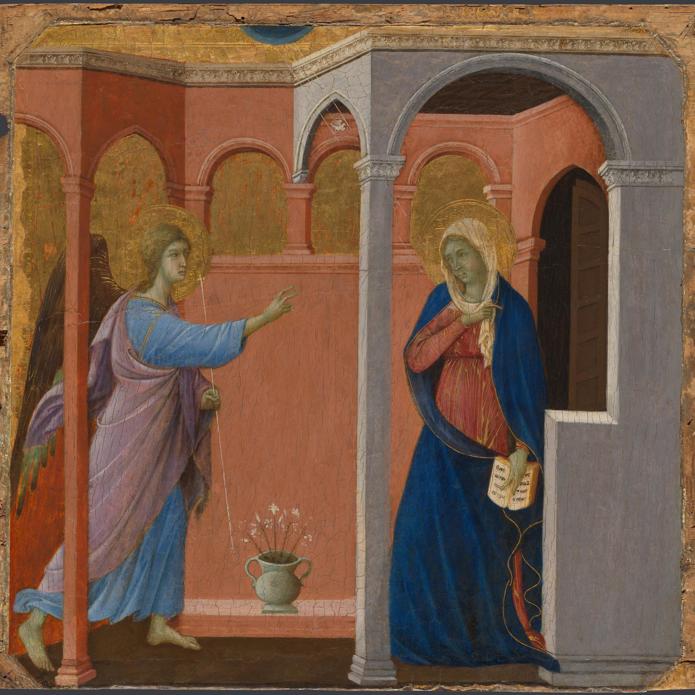
Overview
These three small panels come from the altarpiece known as the Maestà (‘Majesty’), made for Siena Cathedral. It is the only surviving signed work by the city’s leading artist, Duccio di Buoninsegna. These paintings formed part of the predella, the lowest part of the altarpiece.
The Maestà was painted on both sides: The Annunciation comes from the front predella, while the Healing of the Man born Blind and the Transfiguration were originally placed next to each other on the back of the predella. The predella itself was shaped like a rectangular box, with images on both sides, providing support for the large, double-sided picture.
When the picture was completed in 1311 it was carried in a festive procession across the streets of Siena to the cathedral, where it was placed above the high altar. There it became the focus of the Siena’s devotion to the Virgin Mary, who was considered the protector of the city.

